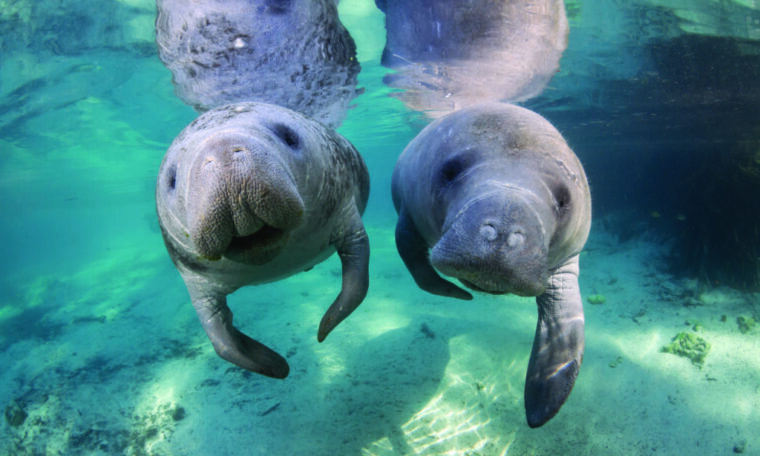
Looking for an exciting and unique eco-tour? Florida’s subtropical climate and convenient access give you that and so much more! All types of people can (and do) go on outdoor adventures here. Abundant tour options enable visitors to see and experience Florida animals in the wild. Tourism and development pressure has put many species and habitats at risk but these are the stories of how your vacation dollars help protect and preserve these endangered species.
Manatee Encounters in Crystal River 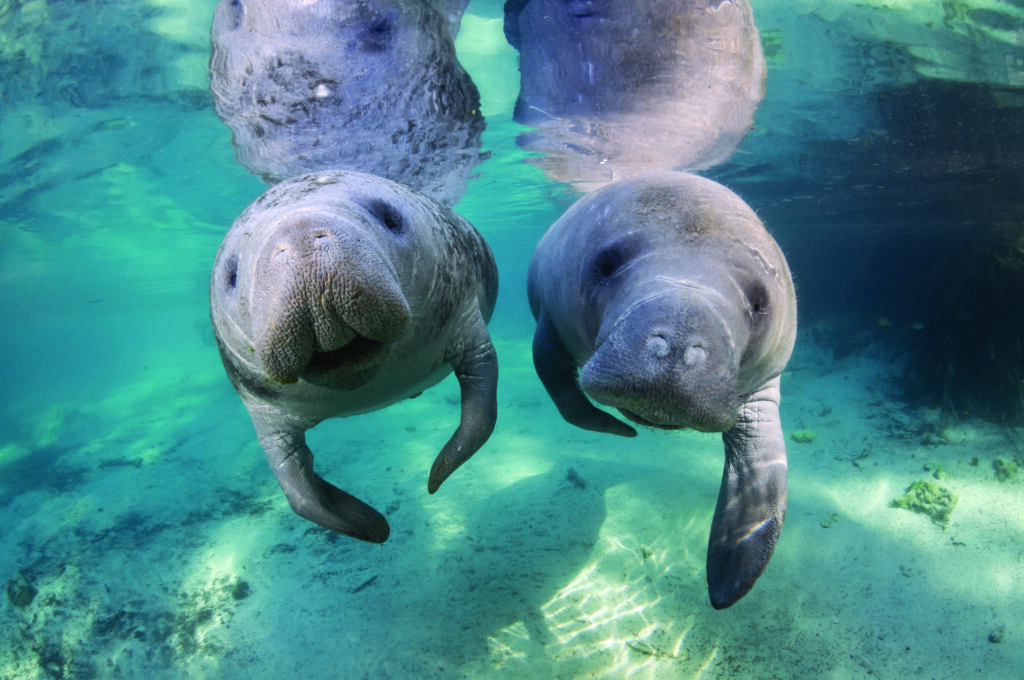 Photo Credit: Discover Crystal River Florida.
Photo Credit: Discover Crystal River Florida.
By now, most people know what a manatee is. They are the cute marine mammals that congregate in the springs during the winter and eat a lot. Their closest living relative is the elephant if that tells you something about their diet and appetite. They are also our favorite wild animals in Florida and our favorite weekend getaway in Florida.
Forty years ago, there wasn’t this kind of awareness. People called manatees funny looking speed bumps. The population was in steep decline, and boat strikes alone threatened to push them into extinction. Luckily, the state and Federal Government started to develop protection plans to save these gentle giants. These plans centered on using tourism to help spread the message.
The Florida Manatee Recovery Plan states – “Media coverage of manatee rescues, treatments, and releases helps to educate millions of people about manatees, the life-threatening problems that they face… In addition, more than eighteen million visitors a year see manatees at rehabilitation facilities and participate in manatee education programs sponsored by several parks. The publicity and outreach inherent in this program provide significant support to efforts to recover the manatee… Manatee viewing opportunities have also been made available to the public… Such efforts are essential for obtaining public compliance with conservation measures to protect manatees and their habitats. Many public awareness materials have been developed specifically focusing on boater education.“
Thanks to literally millions of people becoming involved, manatees have left the endangered list in Florida. They aren’t out of the woods yet, but there’s hope that you can continue to swim with manatees in Florida for years to come.
Diving on Coral Reefs in the Florida Keys  Photo Credit: Deposit Photos.
Photo Credit: Deposit Photos.
The Florida Keys boasts about how they have the only living coral barrier reef in America. Tour operators take boatloads of people every day to dive and snorkel in this underwater playground. However, if you read between the lines, you realize that the coral reefs of the Florida Keys are at the northern edge of their habitat. That makes the ecosystem vulnerable. As a matter of fact, Key West recently voted in a law to ban the sale of non-reef-safe sunscreen(sunscreen products containing oxybenzone and octinoxate) believed to damage coral reefs. (This progressive policy took effect January 1, 2021)
In recent years, El Nino / La Nina weather patterns exposed the vulnerability of the reef system. Coral reefs are a complex symbiotic community of polyps and algae. When the reef is stressed, it releases the algae in a process called coral bleaching. Bleaching alone can recover quickly, but the stress exposes the ecosystem to diseases like white-band and blank-band coral disease. These are infections that can wipe out entire reefs very quickly. When the reefs go, the Florida animals living on them will soon follow.
Scientists and volunteers have been working tirelessly to fight these devastating threats. They are treating infected corals and propagating disease-resistant species. Right now, they are working to contain the disease and save the species. The economic value of these reefs to the Florida Keys is, in part, why Florida’s Governor DeSantis is recommending $277,650 for “Monroe County Reef Protection.”
Dolphin Tours in Panama City Beach  Photo Credit: Jenn Coleman.
Photo Credit: Jenn Coleman.
It seems like every beach town in Florida has some kind of dolphin tour rolling, for good reason too. These little guys are pretty darn cute and we love it that people are seeing them in nature instead of dolphin shows. However, Panama City Beach and its adjacent St Andrews Bay offer something particularly unique – the world’s largest population of Bottlenose Dolphins. Of course, with a draw like that, a lot of people get into the dolphin tour business, which isn’t necessarily a bad thing.
St Andrew’s Bay is a particularly vulnerable ecosystem because it has minimal tides combined with a small influx of fresh water. Advocacy groups, like the Friends of St Andrew’s Bay, are taking up the banner to protect this resource. They put it so eloquently – “We can lose a great number of species within our nationally-significant ecosystem if we don’t care for it properly. If the water becomes turbid or if sediments become contaminated, we can lose everything. Property values, recreation, and fishing are also at stake. We don’t want to lose our biological treasure and the social benefits it provides.”
Sea Turtle Hatching in Fort Lauderdale  Photo Credit: Deposit Photos.
Photo Credit: Deposit Photos.
When Europeans first came to Florida, they loved sea turtles because they could stay alive for months upside down in the ship’s hold until they were finally eaten. Green turtle soup canneries have decimated that species in Florida. Somewhere between the 1973 Sea Turtle Protection Act and Crush, the dude-ing turtle from Finding Nemo, sentiments have changed. Nothing captures the poetic struggle of life more beautifully than baby sea turtles hatching and rushing towards the ocean. It’s mad and perfect at the same time. Seeing these little guys running down the beach to swim out into the open ocean captures the spirit of hope in all of us.
We had an opportunity to watch a turtle hatch for ourselves with Sea Turtle Oversight Protection, a community group dedicated to saving baby sea turtles. All summer long, their volunteers watch nests that are about to hatch and help the hatchlings to the ocean if they get confused by the bright lights of Fort Lauderdale. To date, they have saved over 200,000 (yes five zeros!) baby sea turtles who would have otherwise died on the beach or on the road. (Hooray for endangered species in Florida!)
Despite growing as a tourist destination, Fort Lauderdale is now neck and neck with Oman as the largest turtle hatchery. In 1985, only 1216 turtles nested in Broward County. Today, that number is about 4,000 with more coming every year. Conservationists mark the nests and help the hatch, but you can see this midsummer miracle for yourself as an eco-tourist.
The Elusive Florida Panthers of the Everglades  Photo Credit: Deposit Photos.
Photo Credit: Deposit Photos.
There are some Florida animals you’re not likely to see, but that doesn’t mean tourism isn’t helping them too. Per the Florida Panther Recovery Plan – “Panthers require large, contiguous areas of suitable habitat to meet their social, reproductive, and energetic needs. Panther habitat selection is related to prey availability, which means they select habitats that make prey vulnerable to stalking and capturing. Dense understory vegetation provides some of the most important feeding, resting, and denning cover for panthers.“
The plan goes on to explain “The breeding range of the Florida panther population is currently restricted to habitat south of the Caloosahatchee River in southern Florida.” For the lay folk, it means Everglades National Park and the associated wildlife preserves. Activities, like airboat rides in the Everglades, introduce people to this unique ecosystem and dispel myths and fears about swamps. People are learning why wetlands are worth saving instead of draining for more condos. Is it working?
The Florida panther population has increased from about 20 adults in the early 70’s to almost 300 adults today. Breeding females have been found north of the Caloosahatchee with individuals regaining historic ranges in Georgia. Scientists continue to fight the fight and introduce fresh genetic stock from related pumas in Texas, but it’s up to us to choose the wildlife of the Everglades over the nightlife of Miami.
Miniature Key Deer on Big Pine Key  Photo Credit: Deposit Photos.
Photo Credit: Deposit Photos.
Have you ever heard of a Key Deer before? Perhaps not because there’s only 800 of them in the world and they only live in the Florida Keys. But, if you’ve ever seen Rudolf the Rednose Reindeer cartoon, they look just like that (minus the nose). They are about the size of a big dog and cute as a puppy.
Not so long ago, Key Deer were a few gunshots from being extinct. Poaching in the 1950s reduced the population to only a few dozen animals. The establishment of the Key Deer Refuge and the subsequent 1967 status of the endangered species act allowed for a dramatic recovery of the species. Now, nearly a thousand Key Deer live in the Keys, mostly around Big Pine and No Name Key.
When you’re planning your visit to the Keys, consider visiting the refuge to see these cuties for yourself. It will be a reminder of why you should drive the speed limit on Highway 1, especially at night when these Florida animals are more active.
Goliath Grouper Aggregation on Florida Shipwrecks 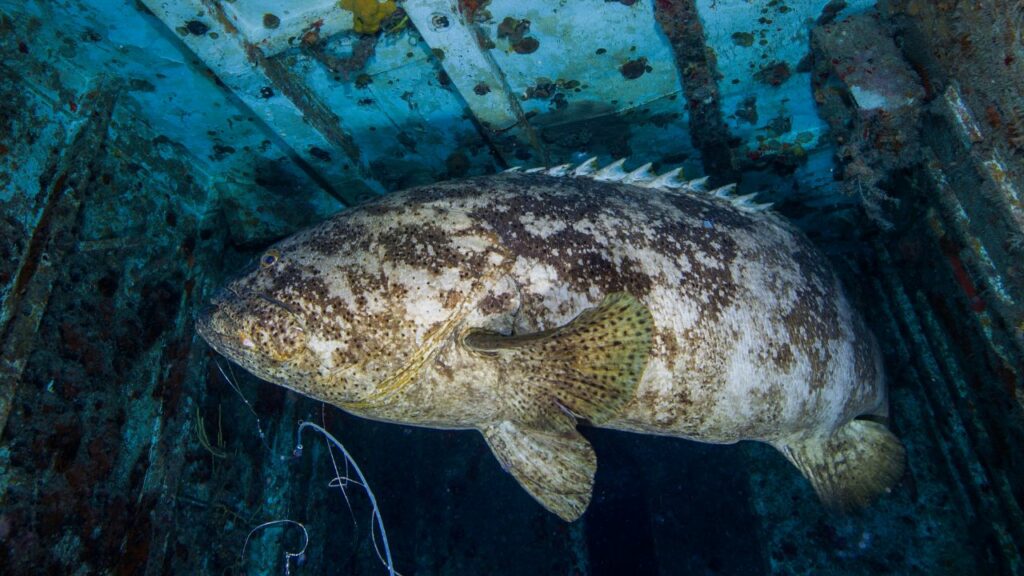 Photo Credit: Deposit Photos.
Photo Credit: Deposit Photos.
For our next “only in Florida animal encounter” we have the Goliath Grouper aggregation. They are the diametric opposite of Key Deer in every way except how ecotourism is helping to save the species. These enormous fish are the apex predators in the shallow reefs surrounding Florida. Epinephelus itajara, aka Goliath Grouper, are the largest grouper species in the Atlantic Ocean weighing up to 800 pounds.
They were considered for inclusion on the endangered species act in 1991. By 1993, all commercial fishing was prohibited in Florida and the Caribbean. Florida began to add artificial reefs along the coast from Miami up to Palm Beach. In all, about 300 ships were sunk along the coast. The grouper population responded well. By 2006 they were removed from the species of concern list.
With numerous shipwrecks populated by 800 lb fish, the Florida Reef Tract has become a destination dive location. Perhaps the most famous dive is the grouper aggregation on the M/V Castor in Palm Beach. In the late summer, hundreds of enormous fish gather on this deep wreck in one of the most impressive pelagic viewing dives on the planet.
Florida’s Wild Monkeys 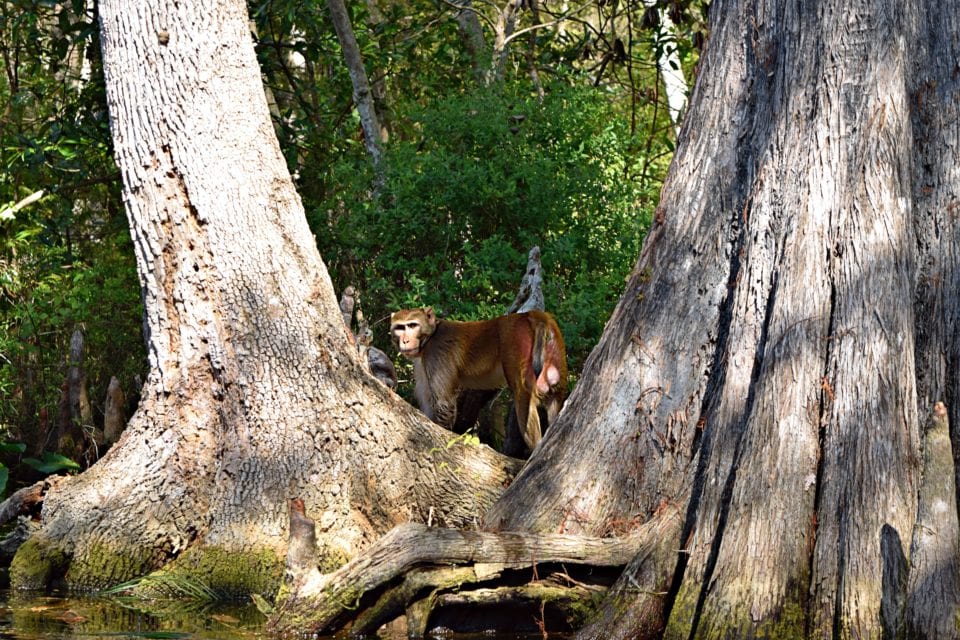 Photo Credit: Jenn Coleman.
Photo Credit: Jenn Coleman.
On the Silver River, near Silver Springs State Park, eco-tourists can experience another ‘Only in Florida’ encounter – wild monkeys. If you have the means to travel the world, you’re bound to see monkeys in the wild, but for many blue-collar tourists, this might be their only chance.
No, these monkeys aren’t native Florida animals. In 1938 Colonel Tooey imported six monkeys for his wild Jungle Cruise. A few years later, he brought in six more. Now, over 200 monkeys are swinging through the cypress swamps. That means this entire population came from a minimal genetic stock. Only, unlike the Florida panther, scientists are not looking to introduce genetic diversity. You can see their crooked tails and other traits from a shallow gene pool in this isolated population. Even if they are a non-native species, a kayak trip down the Silver River is still a fascinating and fun animal encounter! Native or not, they are wild animals so don’t feed, approach, or harass the monkeys. Just enjoy them from a distance.
Hope for Florida Animals 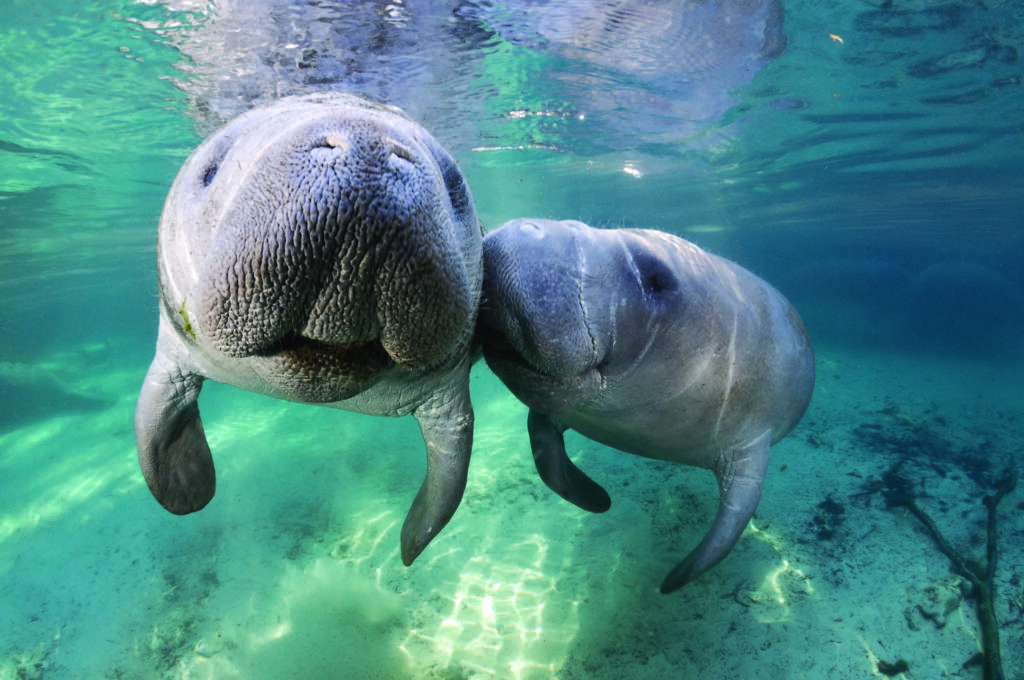 Photo Credit: Discover Crystal River Florida.
Photo Credit: Discover Crystal River Florida.
Animal encounters only in Florida are real. America’s subtropics are filled with stories of challenge, redemption, and thousands of volunteers working to save species and habitat. Eco tourism driven education and funding have helped further that cause. From manatees to sea turtles, dolphins to divers, animals are coming back from the brink and having a fighting chance. We hope you are inspired to come to Florida for an amazing eco-adventure.
